Cloud Computing in Warehouse Management System Analysis Report
VerifiedAdded on 2022/10/10
|8
|1703
|485
Report
AI Summary
This report delves into the application of cloud computing within a warehouse management system, specifically focusing on a case study involving 'The Auto-Parts Warehouse.' It begins with an introduction to cloud computing and its potential benefits for the warehouse. The report then explores the various features of cloud-based solutions, highlighting both their strengths and weaknesses, and how they can be implemented to improve the warehouse's operations. A key part of the report compares and contrasts the Unified Process (UP) and SCRUM agile methodologies, ultimately recommending SCRUM as the most suitable approach for the Auto-Parts Warehouse system. The rationale behind this recommendation is provided, along with a conclusion summarizing the overall impact of cloud computing and the chosen methodology on the warehouse management system. The report emphasizes cost reduction, increased efficiency, reliability, and the importance of adapting to customer needs through the selected methodology. It also acknowledges potential risks such as internet dependency and data security concerns.
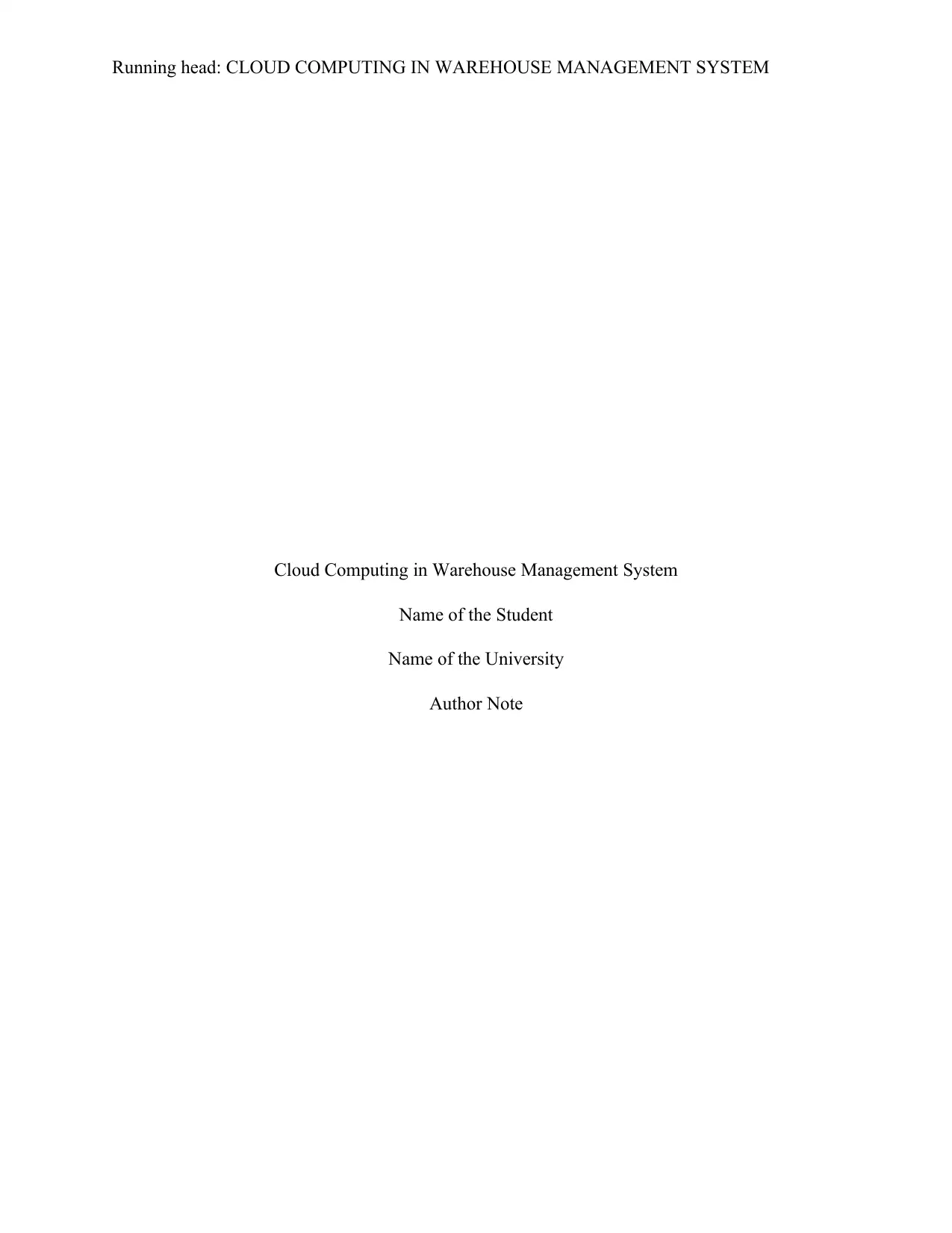
Running head: CLOUD COMPUTING IN WAREHOUSE MANAGEMENT SYSTEM
Cloud Computing in Warehouse Management System
Name of the Student
Name of the University
Author Note
Cloud Computing in Warehouse Management System
Name of the Student
Name of the University
Author Note
Paraphrase This Document
Need a fresh take? Get an instant paraphrase of this document with our AI Paraphraser
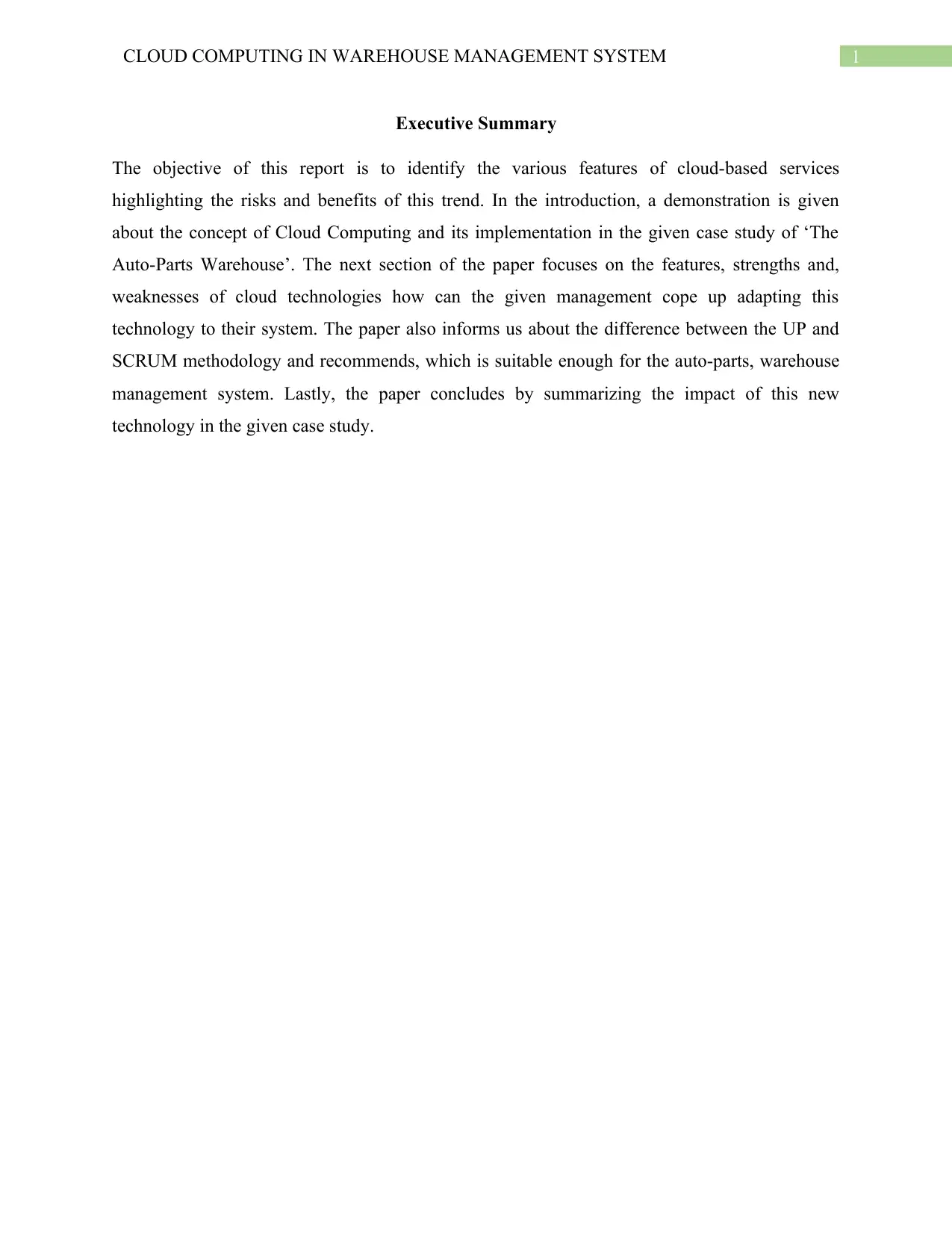
1CLOUD COMPUTING IN WAREHOUSE MANAGEMENT SYSTEM
Executive Summary
The objective of this report is to identify the various features of cloud-based services
highlighting the risks and benefits of this trend. In the introduction, a demonstration is given
about the concept of Cloud Computing and its implementation in the given case study of ‘The
Auto-Parts Warehouse’. The next section of the paper focuses on the features, strengths and,
weaknesses of cloud technologies how can the given management cope up adapting this
technology to their system. The paper also informs us about the difference between the UP and
SCRUM methodology and recommends, which is suitable enough for the auto-parts, warehouse
management system. Lastly, the paper concludes by summarizing the impact of this new
technology in the given case study.
Executive Summary
The objective of this report is to identify the various features of cloud-based services
highlighting the risks and benefits of this trend. In the introduction, a demonstration is given
about the concept of Cloud Computing and its implementation in the given case study of ‘The
Auto-Parts Warehouse’. The next section of the paper focuses on the features, strengths and,
weaknesses of cloud technologies how can the given management cope up adapting this
technology to their system. The paper also informs us about the difference between the UP and
SCRUM methodology and recommends, which is suitable enough for the auto-parts, warehouse
management system. Lastly, the paper concludes by summarizing the impact of this new
technology in the given case study.
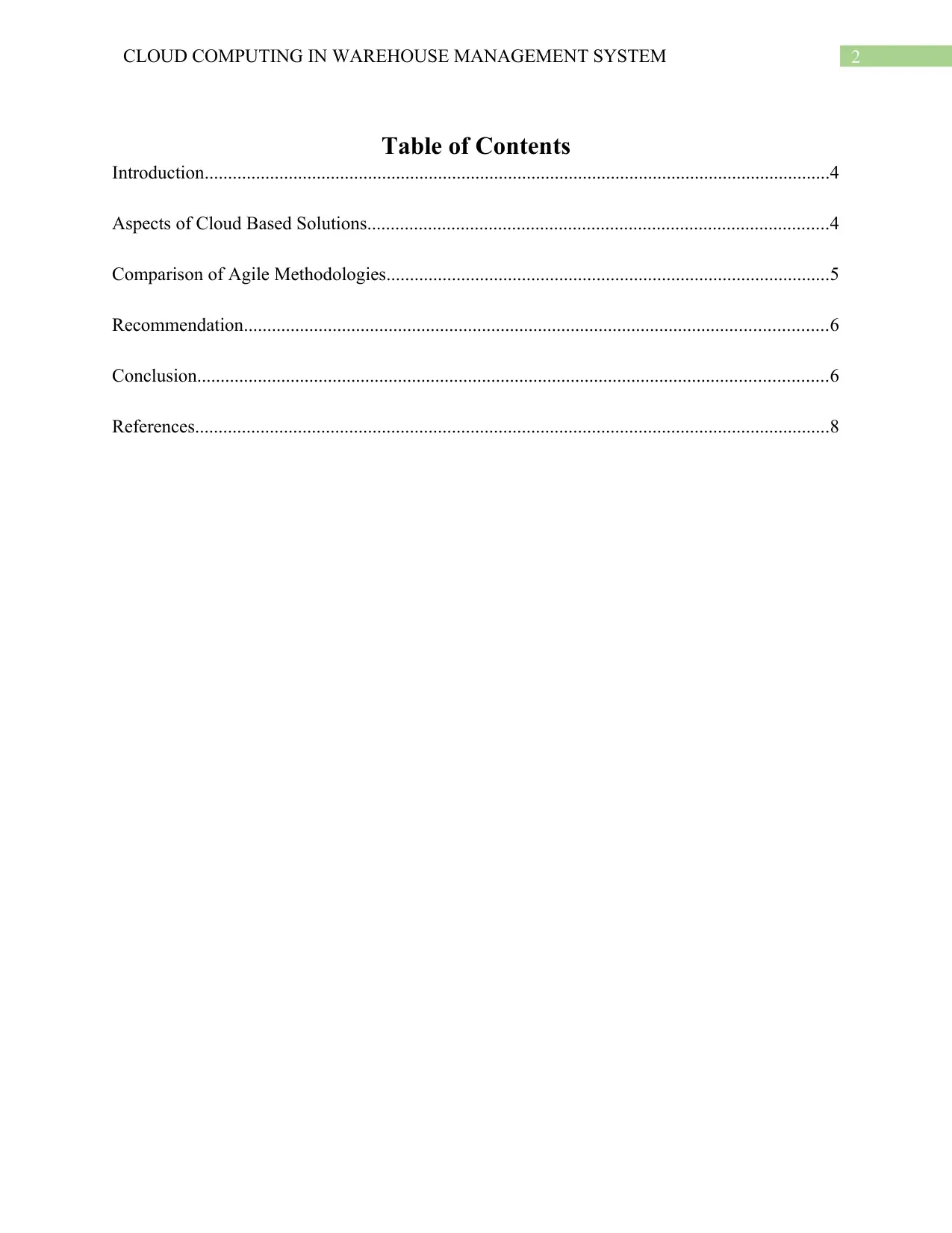
2CLOUD COMPUTING IN WAREHOUSE MANAGEMENT SYSTEM
Table of Contents
Introduction......................................................................................................................................4
Aspects of Cloud Based Solutions...................................................................................................4
Comparison of Agile Methodologies...............................................................................................5
Recommendation.............................................................................................................................6
Conclusion.......................................................................................................................................6
References........................................................................................................................................8
Table of Contents
Introduction......................................................................................................................................4
Aspects of Cloud Based Solutions...................................................................................................4
Comparison of Agile Methodologies...............................................................................................5
Recommendation.............................................................................................................................6
Conclusion.......................................................................................................................................6
References........................................................................................................................................8
⊘ This is a preview!⊘
Do you want full access?
Subscribe today to unlock all pages.

Trusted by 1+ million students worldwide
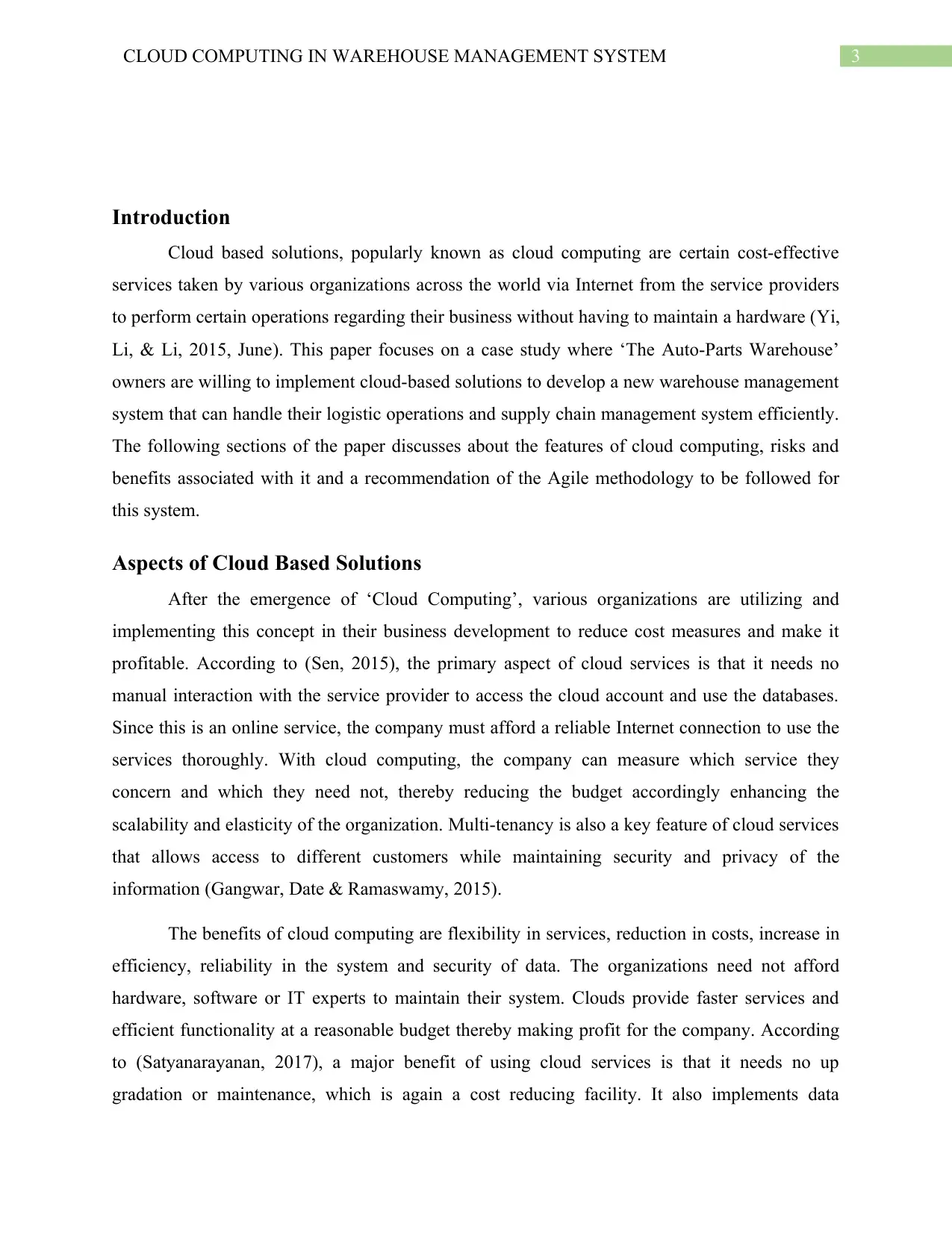
3CLOUD COMPUTING IN WAREHOUSE MANAGEMENT SYSTEM
Introduction
Cloud based solutions, popularly known as cloud computing are certain cost-effective
services taken by various organizations across the world via Internet from the service providers
to perform certain operations regarding their business without having to maintain a hardware (Yi,
Li, & Li, 2015, June). This paper focuses on a case study where ‘The Auto-Parts Warehouse’
owners are willing to implement cloud-based solutions to develop a new warehouse management
system that can handle their logistic operations and supply chain management system efficiently.
The following sections of the paper discusses about the features of cloud computing, risks and
benefits associated with it and a recommendation of the Agile methodology to be followed for
this system.
Aspects of Cloud Based Solutions
After the emergence of ‘Cloud Computing’, various organizations are utilizing and
implementing this concept in their business development to reduce cost measures and make it
profitable. According to (Sen, 2015), the primary aspect of cloud services is that it needs no
manual interaction with the service provider to access the cloud account and use the databases.
Since this is an online service, the company must afford a reliable Internet connection to use the
services thoroughly. With cloud computing, the company can measure which service they
concern and which they need not, thereby reducing the budget accordingly enhancing the
scalability and elasticity of the organization. Multi-tenancy is also a key feature of cloud services
that allows access to different customers while maintaining security and privacy of the
information (Gangwar, Date & Ramaswamy, 2015).
The benefits of cloud computing are flexibility in services, reduction in costs, increase in
efficiency, reliability in the system and security of data. The organizations need not afford
hardware, software or IT experts to maintain their system. Clouds provide faster services and
efficient functionality at a reasonable budget thereby making profit for the company. According
to (Satyanarayanan, 2017), a major benefit of using cloud services is that it needs no up
gradation or maintenance, which is again a cost reducing facility. It also implements data
Introduction
Cloud based solutions, popularly known as cloud computing are certain cost-effective
services taken by various organizations across the world via Internet from the service providers
to perform certain operations regarding their business without having to maintain a hardware (Yi,
Li, & Li, 2015, June). This paper focuses on a case study where ‘The Auto-Parts Warehouse’
owners are willing to implement cloud-based solutions to develop a new warehouse management
system that can handle their logistic operations and supply chain management system efficiently.
The following sections of the paper discusses about the features of cloud computing, risks and
benefits associated with it and a recommendation of the Agile methodology to be followed for
this system.
Aspects of Cloud Based Solutions
After the emergence of ‘Cloud Computing’, various organizations are utilizing and
implementing this concept in their business development to reduce cost measures and make it
profitable. According to (Sen, 2015), the primary aspect of cloud services is that it needs no
manual interaction with the service provider to access the cloud account and use the databases.
Since this is an online service, the company must afford a reliable Internet connection to use the
services thoroughly. With cloud computing, the company can measure which service they
concern and which they need not, thereby reducing the budget accordingly enhancing the
scalability and elasticity of the organization. Multi-tenancy is also a key feature of cloud services
that allows access to different customers while maintaining security and privacy of the
information (Gangwar, Date & Ramaswamy, 2015).
The benefits of cloud computing are flexibility in services, reduction in costs, increase in
efficiency, reliability in the system and security of data. The organizations need not afford
hardware, software or IT experts to maintain their system. Clouds provide faster services and
efficient functionality at a reasonable budget thereby making profit for the company. According
to (Satyanarayanan, 2017), a major benefit of using cloud services is that it needs no up
gradation or maintenance, which is again a cost reducing facility. It also implements data
Paraphrase This Document
Need a fresh take? Get an instant paraphrase of this document with our AI Paraphraser
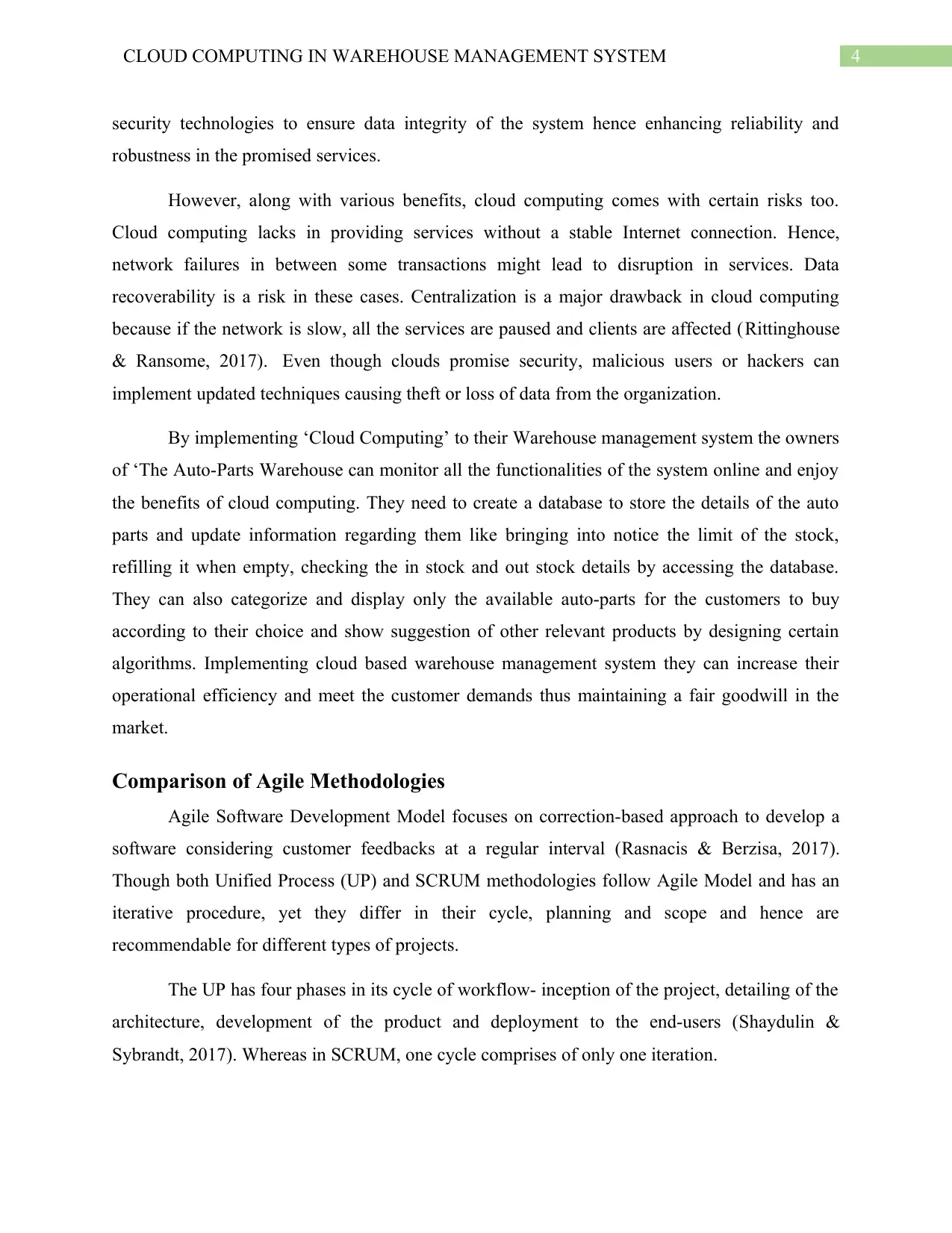
4CLOUD COMPUTING IN WAREHOUSE MANAGEMENT SYSTEM
security technologies to ensure data integrity of the system hence enhancing reliability and
robustness in the promised services.
However, along with various benefits, cloud computing comes with certain risks too.
Cloud computing lacks in providing services without a stable Internet connection. Hence,
network failures in between some transactions might lead to disruption in services. Data
recoverability is a risk in these cases. Centralization is a major drawback in cloud computing
because if the network is slow, all the services are paused and clients are affected (Rittinghouse
& Ransome, 2017). Even though clouds promise security, malicious users or hackers can
implement updated techniques causing theft or loss of data from the organization.
By implementing ‘Cloud Computing’ to their Warehouse management system the owners
of ‘The Auto-Parts Warehouse can monitor all the functionalities of the system online and enjoy
the benefits of cloud computing. They need to create a database to store the details of the auto
parts and update information regarding them like bringing into notice the limit of the stock,
refilling it when empty, checking the in stock and out stock details by accessing the database.
They can also categorize and display only the available auto-parts for the customers to buy
according to their choice and show suggestion of other relevant products by designing certain
algorithms. Implementing cloud based warehouse management system they can increase their
operational efficiency and meet the customer demands thus maintaining a fair goodwill in the
market.
Comparison of Agile Methodologies
Agile Software Development Model focuses on correction-based approach to develop a
software considering customer feedbacks at a regular interval (Rasnacis & Berzisa, 2017).
Though both Unified Process (UP) and SCRUM methodologies follow Agile Model and has an
iterative procedure, yet they differ in their cycle, planning and scope and hence are
recommendable for different types of projects.
The UP has four phases in its cycle of workflow- inception of the project, detailing of the
architecture, development of the product and deployment to the end-users (Shaydulin &
Sybrandt, 2017). Whereas in SCRUM, one cycle comprises of only one iteration.
security technologies to ensure data integrity of the system hence enhancing reliability and
robustness in the promised services.
However, along with various benefits, cloud computing comes with certain risks too.
Cloud computing lacks in providing services without a stable Internet connection. Hence,
network failures in between some transactions might lead to disruption in services. Data
recoverability is a risk in these cases. Centralization is a major drawback in cloud computing
because if the network is slow, all the services are paused and clients are affected (Rittinghouse
& Ransome, 2017). Even though clouds promise security, malicious users or hackers can
implement updated techniques causing theft or loss of data from the organization.
By implementing ‘Cloud Computing’ to their Warehouse management system the owners
of ‘The Auto-Parts Warehouse can monitor all the functionalities of the system online and enjoy
the benefits of cloud computing. They need to create a database to store the details of the auto
parts and update information regarding them like bringing into notice the limit of the stock,
refilling it when empty, checking the in stock and out stock details by accessing the database.
They can also categorize and display only the available auto-parts for the customers to buy
according to their choice and show suggestion of other relevant products by designing certain
algorithms. Implementing cloud based warehouse management system they can increase their
operational efficiency and meet the customer demands thus maintaining a fair goodwill in the
market.
Comparison of Agile Methodologies
Agile Software Development Model focuses on correction-based approach to develop a
software considering customer feedbacks at a regular interval (Rasnacis & Berzisa, 2017).
Though both Unified Process (UP) and SCRUM methodologies follow Agile Model and has an
iterative procedure, yet they differ in their cycle, planning and scope and hence are
recommendable for different types of projects.
The UP has four phases in its cycle of workflow- inception of the project, detailing of the
architecture, development of the product and deployment to the end-users (Shaydulin &
Sybrandt, 2017). Whereas in SCRUM, one cycle comprises of only one iteration.
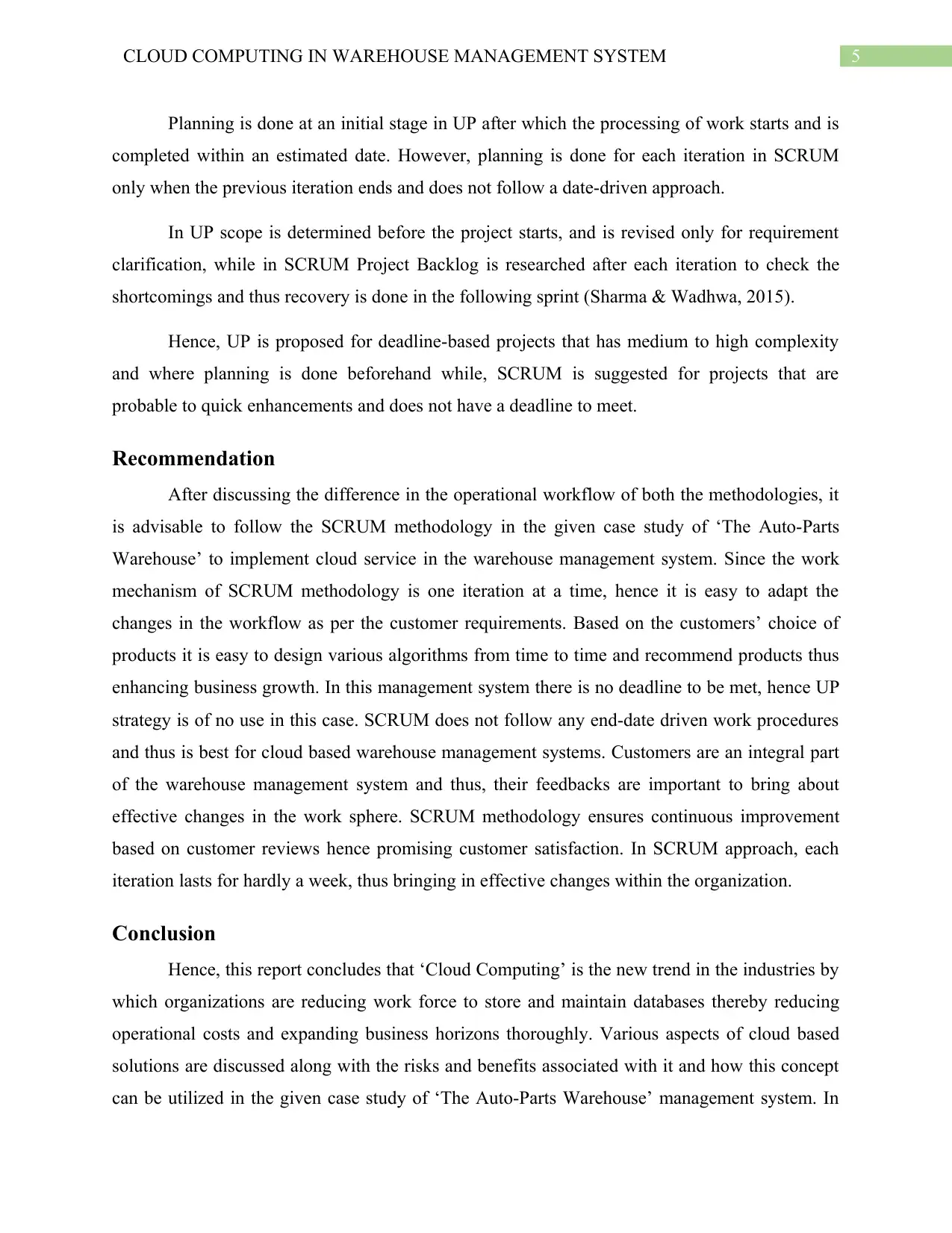
5CLOUD COMPUTING IN WAREHOUSE MANAGEMENT SYSTEM
Planning is done at an initial stage in UP after which the processing of work starts and is
completed within an estimated date. However, planning is done for each iteration in SCRUM
only when the previous iteration ends and does not follow a date-driven approach.
In UP scope is determined before the project starts, and is revised only for requirement
clarification, while in SCRUM Project Backlog is researched after each iteration to check the
shortcomings and thus recovery is done in the following sprint (Sharma & Wadhwa, 2015).
Hence, UP is proposed for deadline-based projects that has medium to high complexity
and where planning is done beforehand while, SCRUM is suggested for projects that are
probable to quick enhancements and does not have a deadline to meet.
Recommendation
After discussing the difference in the operational workflow of both the methodologies, it
is advisable to follow the SCRUM methodology in the given case study of ‘The Auto-Parts
Warehouse’ to implement cloud service in the warehouse management system. Since the work
mechanism of SCRUM methodology is one iteration at a time, hence it is easy to adapt the
changes in the workflow as per the customer requirements. Based on the customers’ choice of
products it is easy to design various algorithms from time to time and recommend products thus
enhancing business growth. In this management system there is no deadline to be met, hence UP
strategy is of no use in this case. SCRUM does not follow any end-date driven work procedures
and thus is best for cloud based warehouse management systems. Customers are an integral part
of the warehouse management system and thus, their feedbacks are important to bring about
effective changes in the work sphere. SCRUM methodology ensures continuous improvement
based on customer reviews hence promising customer satisfaction. In SCRUM approach, each
iteration lasts for hardly a week, thus bringing in effective changes within the organization.
Conclusion
Hence, this report concludes that ‘Cloud Computing’ is the new trend in the industries by
which organizations are reducing work force to store and maintain databases thereby reducing
operational costs and expanding business horizons thoroughly. Various aspects of cloud based
solutions are discussed along with the risks and benefits associated with it and how this concept
can be utilized in the given case study of ‘The Auto-Parts Warehouse’ management system. In
Planning is done at an initial stage in UP after which the processing of work starts and is
completed within an estimated date. However, planning is done for each iteration in SCRUM
only when the previous iteration ends and does not follow a date-driven approach.
In UP scope is determined before the project starts, and is revised only for requirement
clarification, while in SCRUM Project Backlog is researched after each iteration to check the
shortcomings and thus recovery is done in the following sprint (Sharma & Wadhwa, 2015).
Hence, UP is proposed for deadline-based projects that has medium to high complexity
and where planning is done beforehand while, SCRUM is suggested for projects that are
probable to quick enhancements and does not have a deadline to meet.
Recommendation
After discussing the difference in the operational workflow of both the methodologies, it
is advisable to follow the SCRUM methodology in the given case study of ‘The Auto-Parts
Warehouse’ to implement cloud service in the warehouse management system. Since the work
mechanism of SCRUM methodology is one iteration at a time, hence it is easy to adapt the
changes in the workflow as per the customer requirements. Based on the customers’ choice of
products it is easy to design various algorithms from time to time and recommend products thus
enhancing business growth. In this management system there is no deadline to be met, hence UP
strategy is of no use in this case. SCRUM does not follow any end-date driven work procedures
and thus is best for cloud based warehouse management systems. Customers are an integral part
of the warehouse management system and thus, their feedbacks are important to bring about
effective changes in the work sphere. SCRUM methodology ensures continuous improvement
based on customer reviews hence promising customer satisfaction. In SCRUM approach, each
iteration lasts for hardly a week, thus bringing in effective changes within the organization.
Conclusion
Hence, this report concludes that ‘Cloud Computing’ is the new trend in the industries by
which organizations are reducing work force to store and maintain databases thereby reducing
operational costs and expanding business horizons thoroughly. Various aspects of cloud based
solutions are discussed along with the risks and benefits associated with it and how this concept
can be utilized in the given case study of ‘The Auto-Parts Warehouse’ management system. In
⊘ This is a preview!⊘
Do you want full access?
Subscribe today to unlock all pages.

Trusted by 1+ million students worldwide
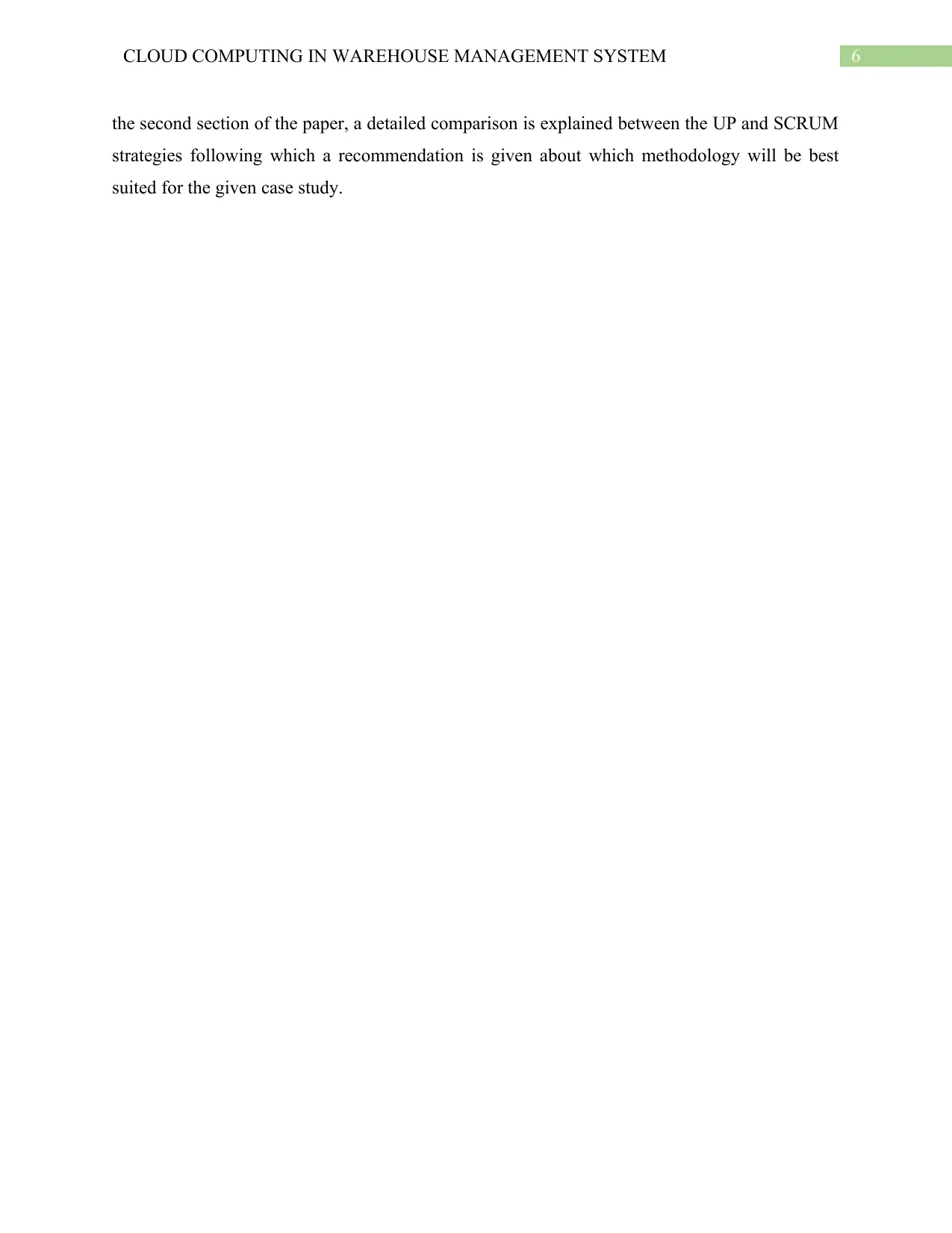
6CLOUD COMPUTING IN WAREHOUSE MANAGEMENT SYSTEM
the second section of the paper, a detailed comparison is explained between the UP and SCRUM
strategies following which a recommendation is given about which methodology will be best
suited for the given case study.
the second section of the paper, a detailed comparison is explained between the UP and SCRUM
strategies following which a recommendation is given about which methodology will be best
suited for the given case study.
Paraphrase This Document
Need a fresh take? Get an instant paraphrase of this document with our AI Paraphraser
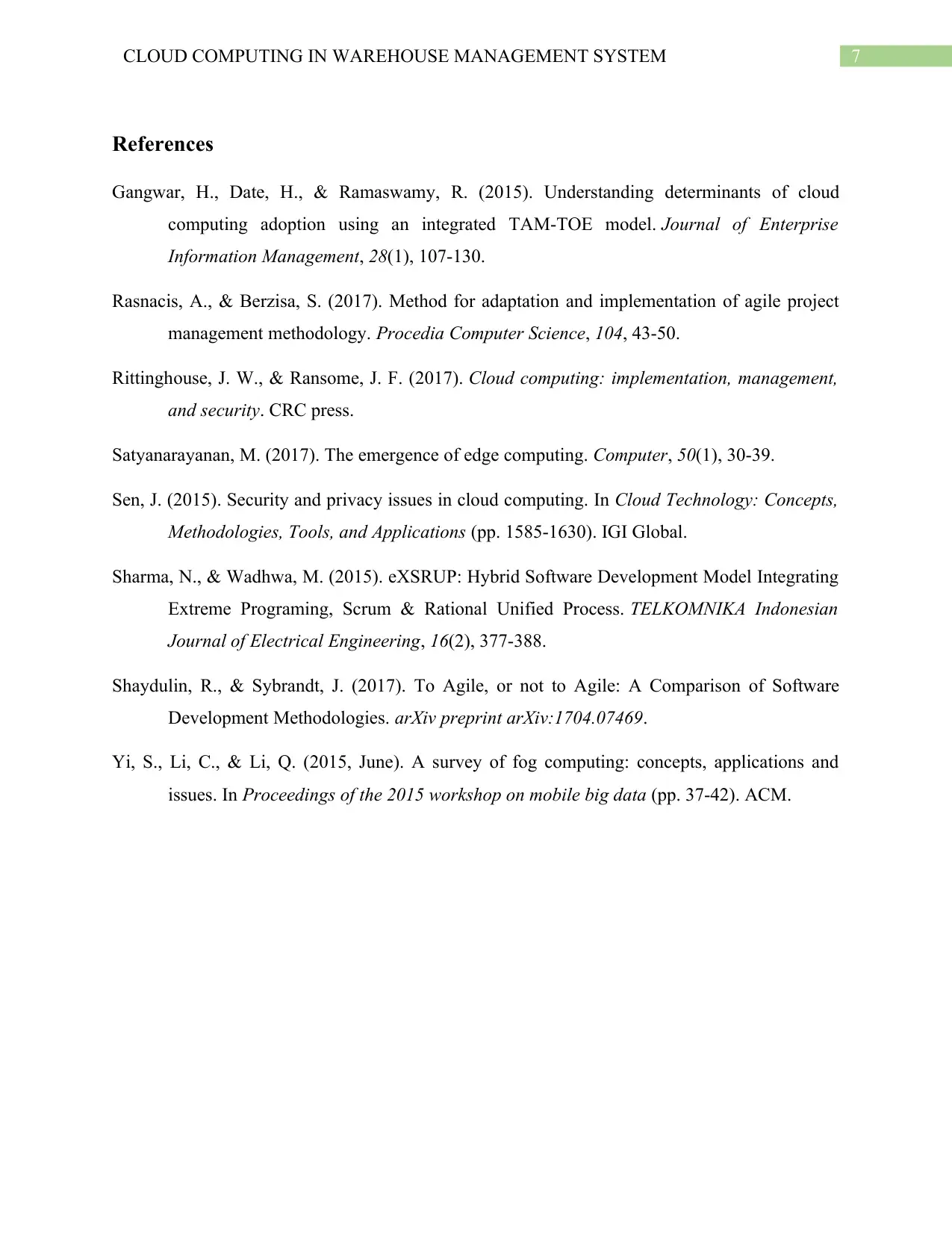
7CLOUD COMPUTING IN WAREHOUSE MANAGEMENT SYSTEM
References
Gangwar, H., Date, H., & Ramaswamy, R. (2015). Understanding determinants of cloud
computing adoption using an integrated TAM-TOE model. Journal of Enterprise
Information Management, 28(1), 107-130.
Rasnacis, A., & Berzisa, S. (2017). Method for adaptation and implementation of agile project
management methodology. Procedia Computer Science, 104, 43-50.
Rittinghouse, J. W., & Ransome, J. F. (2017). Cloud computing: implementation, management,
and security. CRC press.
Satyanarayanan, M. (2017). The emergence of edge computing. Computer, 50(1), 30-39.
Sen, J. (2015). Security and privacy issues in cloud computing. In Cloud Technology: Concepts,
Methodologies, Tools, and Applications (pp. 1585-1630). IGI Global.
Sharma, N., & Wadhwa, M. (2015). eXSRUP: Hybrid Software Development Model Integrating
Extreme Programing, Scrum & Rational Unified Process. TELKOMNIKA Indonesian
Journal of Electrical Engineering, 16(2), 377-388.
Shaydulin, R., & Sybrandt, J. (2017). To Agile, or not to Agile: A Comparison of Software
Development Methodologies. arXiv preprint arXiv:1704.07469.
Yi, S., Li, C., & Li, Q. (2015, June). A survey of fog computing: concepts, applications and
issues. In Proceedings of the 2015 workshop on mobile big data (pp. 37-42). ACM.
References
Gangwar, H., Date, H., & Ramaswamy, R. (2015). Understanding determinants of cloud
computing adoption using an integrated TAM-TOE model. Journal of Enterprise
Information Management, 28(1), 107-130.
Rasnacis, A., & Berzisa, S. (2017). Method for adaptation and implementation of agile project
management methodology. Procedia Computer Science, 104, 43-50.
Rittinghouse, J. W., & Ransome, J. F. (2017). Cloud computing: implementation, management,
and security. CRC press.
Satyanarayanan, M. (2017). The emergence of edge computing. Computer, 50(1), 30-39.
Sen, J. (2015). Security and privacy issues in cloud computing. In Cloud Technology: Concepts,
Methodologies, Tools, and Applications (pp. 1585-1630). IGI Global.
Sharma, N., & Wadhwa, M. (2015). eXSRUP: Hybrid Software Development Model Integrating
Extreme Programing, Scrum & Rational Unified Process. TELKOMNIKA Indonesian
Journal of Electrical Engineering, 16(2), 377-388.
Shaydulin, R., & Sybrandt, J. (2017). To Agile, or not to Agile: A Comparison of Software
Development Methodologies. arXiv preprint arXiv:1704.07469.
Yi, S., Li, C., & Li, Q. (2015, June). A survey of fog computing: concepts, applications and
issues. In Proceedings of the 2015 workshop on mobile big data (pp. 37-42). ACM.
1 out of 8
Related Documents
Your All-in-One AI-Powered Toolkit for Academic Success.
+13062052269
info@desklib.com
Available 24*7 on WhatsApp / Email
![[object Object]](/_next/static/media/star-bottom.7253800d.svg)
Unlock your academic potential
Copyright © 2020–2025 A2Z Services. All Rights Reserved. Developed and managed by ZUCOL.



